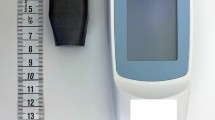Abstract
The aim of this study was to compare predictions of hyperbilirubinaemia by eye, performed by trained physicians and nurses, with predictions obtained using two commercial bilirubinometers. Jaundice was assessed in 92 white and 48 non-white healthy full-term neonates using three non-invasive methods and by total serum bilirubin as the reference method. Clinical assessment of cephalocaudal progression of jaundice was carried out independently by a physician and by nurses. Simultaneously, the Minolta Airshields JM-102 was applied on the sternum, the BiliCheck on both the forehead and the sternum, and finally, serum bilirubin concentrations were determined. The Minolta JM-102 showed the best performance with r2=0.90, an intraclass correlation coefficient (ICC) of 0.93, and a 95% confidence interval (CI) of ±4 units (approx. 56 µmol/l). The BiliCheck performed slightly better on the forehead than over the sternum with r2=0.90, an ICC of 0.88, and a CI of ±62 µmol/l. Assessment of jaundice by eye was least accurate with r2=0.74, an ICC of 0.67, and a CI of ±1.5 zones (corresponding to ±75 µmol/l). Skin pigmentation and ambient light both adversely affected non-invasive bilirubin estimation. Conclusion:All three non-invasive methods are well suited for estimation of serum bilirubin but show large confidence intervals. In healthy term newborns, hyperbilirubinaemia (>250 µmol/l) can be safely ruled out by eye if jaundice does not reach the abdomen or the extremities (Kramer zones 1 and 2), with <22 units (<230 µmol/l) for the Minolta JM-102, or with a cut-off of 190 µmol/l for the BiliCheck. If these respective thresholds are exceeded, serum bilirubin concentrations should be measured.



Similar content being viewed by others
Abbreviations
- CI :
-
95% confidence interval
- ICC :
-
intraclass correlation coefficient
- ROC :
-
receiver operating characteristic
References
Beck M, Kau N, Schlebusch (2003) Transcutaneous bilirubin measurement in newborn infants: evaluation of a new spectrophotometric method. Arch Dis Child Fetal Neonatal Ed 88: F350–F351
Bhutani VK, Gourley GR, Adler S, Kreamer B, Dalin C, Johnson LH (2000) Noninvasive measurement of total serum bilirubin in a multiracial predischarge newborn population to assess the risk of severe hyperbilirubinemia. Pediatrics 106: E17
Bilgen H, Ince Z, Ozek E, Bekiroglu N, Ors R (1998) Transcutaneous measurement of hyperbilirubinaemia: comparison of the Minolta jaundice meter and the Ingram icterometer. Ann Trop Paediatr 18: 325–328
Bland JM, Altman DG (1986) Statistical methods for assessing agreement between two methods of clinical measurement. Lancet 1: 307–310
Briscoe L, Clark S, Yoxall CW (2002) Can transcutaneous bilirubinometry reduce the need for blood tests in jaundiced full term babies? Arch Dis Child Fetal Neonatal Ed 86: F190–F192
Bucher HU, Baumgartner R, Bucher N, Seiler M, Fauchère JC (2000) Artificial sweetener reduces nociceptive reaction in term newborn infants. Early Hum Dev 59: 51–60
Carbonell X, Botet F, Figueras J, Riu-Godo A (2001) Prediction of hyperbilirubinaemia in the healthy term newborn. Acta Paediatr 90: 166–170
Ebbesen F, Rasmussen LM, Wimberley PD (2002) A new transcutaneous bilirubinometer, BiliCheck, used in the neonatal intensive care unit and the maternity ward. Acta Paediatr 91: 203–211
Engle WD, Jackson GL, Sendelbach D, Manning D, Frawley WH (2002) Assessment of a transcutaneous device in the evaluation of neonatal hyperbilirubinemia in a primarily Hispanic population. Pediatrics 110: 61–67
Hanley JA, McNeil BJ (1982) The managing and use of the area under the Receiver Operating Characterisitic(ROC) curve. Radiology 143: 29–36
Harish R, Sharma DB (1998) Transcutaneous bilirubinometry in neonates: evaluation of Minolta Airshields jaundicemeter. Indian Pediatr 35: 264–267
Heick C, Mieth D, Fallenstein F, Schubiger G, Nars PW, Amato M (1982) Transcutaneous bilirubin determination in the newborn infant. Helv Paediatr Acta 37: 589–597
Kramer LI (1969) Advancement of dermal icterus in the jaundiced newborn. Am J Dis Child 118: 454–458
Lee J (1992) Evaluating agreement between two methods for measuring the same quantity: a response. Comput Biol Med 22: 369–371
Maisels MJ, Kring E (1997) Transcutaneous bilirubinometry decreases the need for serum bilirubin measurements and saves money. Pediatrics 99: 599–601
Robertson A, Kazmierczak S, Vos P (2002) Improved transcutaneous bilirubinometry: comparison of SpectR(X) BiliCheck and Minolta Jaundice Meter JM-102 for estimating total serum bilirubin in a normal newborn population. J Perinatol 22: 12–14
Rubaltelli FF, Gourley GR, Loskamp N, Modi N, Roth-Kleiner M, Sender A, Vert P (2001) Transcutaneous bilirubin measurement: a multicenter evaluation of a new device. Pediatrics 107: 1264–1271
Shrout PE and JL F (1979) Intraclass correlations: uses in assessing rater reliability. Psychol Bull 86: 420–427
Szabo P, Wolf M, Bucher HU, Haensse D, Fauchère JC, Arlettaz R (2004) Assessment of jaujndice in preterm neonates: comparison between clinical assessment, two transcutaneous bilirubinometers and serum bilirubin values. Acta Paediatr 93: 1–5
Wick RS (1998) Anwendung des Bilirubinometers während der Phototherapie bei ikterischen Neugeborenen, Thesis, Basel
Wong CM, van Dijk PJ, Laing IA (2002) A comparison of transcutaneous bilirubinometers: SpectRx BiliCheck versus Minolta AirShields. Arch Dis Child Fetal Neonatal Ed 87: F137–140
Yamanouchi I (1980) Transcutaneous bilirubinometry: Preliminary studies of non-invasive transcutaneous bilirubin meter in the Okayma National Hospital. Pediatrics 65: 195–202
Yamauchi Y, Yamanouchi I (1991) Factors affecting transcutaneous bilirubin measurement: effect of daylight. Acta Paediatr Jpn 33: 658–662
Acknowledgements
The authors thank the parents of the infants studied and the nurses for making this study possible. We also thank Konrad Gasser for statistical advice and acknowledge the editorial assistance of Helen Keller-Kurzman and Derek Brown.
Author information
Authors and Affiliations
Corresponding author
Rights and permissions
About this article
Cite this article
Szabo, P., Wolf, M., Bucher, H.U. et al. Detection of hyperbilirubinaemia in jaundiced full-term neonates by eye or by bilirubinometer?. Eur J Pediatr 163, 722–727 (2004). https://doi.org/10.1007/s00431-004-1533-7
Received:
Revised:
Accepted:
Published:
Issue Date:
DOI: https://doi.org/10.1007/s00431-004-1533-7




